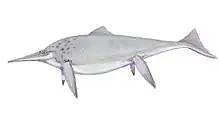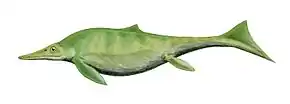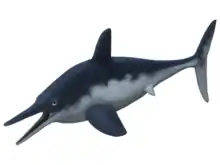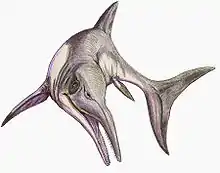| Plutoniosaurus Temporal range: Early Cretaceous, 135-130 Ma | |
|---|---|
| Scientific classification | |
| Kingdom: | |
| Phylum: | |
| Class: | |
| Order: | |
| Family: | |
| Subfamily: | |
| Genus: | †Plutoniosaurus Efimov, 1997 |
| Species | |
| |
Plutoniosaurus is an extinct genus of ophthalmosaurid ichthyosaur of uncertain validity from the Early Cretaceous (late Hauterivian) of the vicinity of Ulyanovsk, European Russia.
Taxonomy
Plutoniosaurus was named by Vladimir Efimov in 1997 based on the holotype specimen UPM 2/740, a partial skeleton. In 1999, Maxim Arkhangel'skii synonymized the genus with Platypterygius,[1] as did Michael Maisch and Andreas Matzke in 2000.[2]: 82 While agreeing with the synonymy, Christopher McGowan and Ryosuke Motani considered P. bedengensis to be a nomen dubium within the genus in 2003, too poorly known to identify as a distinct species.[3]: 136 In 2016, Valentin Fischer and colleagues considered the original description was too vague to confidently distinguish the genus and noted that the illustrations did not always match the written description. They thus regarded Plutoniosaurus bedengensis as a species inquirenda, while noting the possibility that it is the same species as the nearly coeval Simbirskiasaurus from the same region.[4]
Phylogeny
Zverkov and Efimov (2019) recovered Plutoniosaurus in a polytomy with the type species of Platypterygius and Leninia.[5] The following cladogram shows a possible phylogenetic position of Plutoniosaurus in Ophthalmosauridae according to the analysis performed by Zverkov and Jacobs (2020).[6]
| Ophthalmosauria |
| ||||||||||||||||||||||||||||||||||||||||||||||||||||||||||||||||||||||||||||||||||||||||||||||||||||||||||||||||||||||||||||||||||||||||||||||||||||||||||||||||||||||||||||||||||||||||||||||||||||||||||||||||||||||||
See also
References
- ↑ Storrs, G. W.; Arkhangel'skii, M. S.; Efimov, V. M. (2000). "Mesozoic marine reptiles of Russia and other former Soviet republics". In Benton, M. J.; Shishkin, M. A.; Unwin, D. M.; Kurochkin, E. N. (eds.). The Age of Dinosaurs in Russia and Mongolia. Cambridge: Cambridge University Press. pp. 187–210.
- ↑ Maisch, M. W.; Matzke, A. T. (2000). "The Ichthyosauria". Stuttgarter Beiträge zur Naturkunde, Serie B. 298: 1–159.
- ↑ McGowan, C.; Motani, R. (2003). Sues, H.D. (ed.). Handbook of Paleoherpetology Part 8: Ichthyopterygia. Munich: Verlag Dr. Friedrich Pfeil. ISBN 3899370074.
- ↑ Fischer, V.; Bardet, N.; Benson, R. B. J.; Arkhangelsky, M. S.; Friedman, M. (2016). "Extinction of fish-shaped marine reptiles associated with reduced evolutionary rates and global environmental volatility". Nature Communications. 7: 10825. doi:10.1038/ncomms10825. PMC 4786747.
- ↑ Zverkov, N. G.; Efimov, V. M. (2019). "Revision of Undorosaurus, a mysterious Late Jurassic ichthyosaur of the Boreal Realm" (PDF). Journal of Systematic Palaeontology. 17 (14): 963–993. doi:10.1080/14772019.2018.1515793.
- ↑ Zverkov, N. G.; Jacobs, M. L. (2021) [2020]. "Revision of Nannopterygius (Ichthyosauria: Ophthalmosauridae): reappraisal of the 'inaccessible' holotype resolves a taxonomic tangle and reveals an obscure ophthalmosaurid lineage with a wide distribution". Zoological Journal of the Linnean Society. 191 (1): 228–275. doi:10.1093/zoolinnean/zlaa028.







